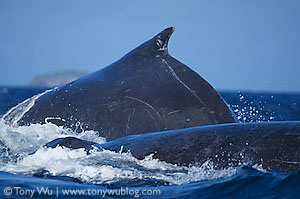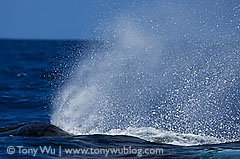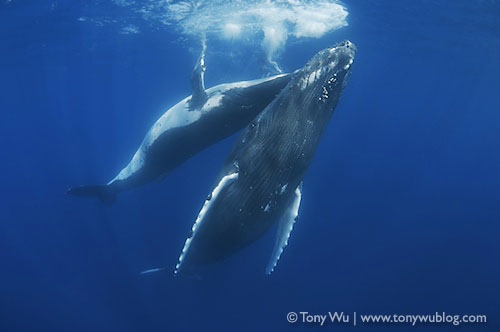Tony Wu blogs from Tonga: Week One with Humpbacks

Current status of the whales in Tonga: The boys are horny; the girls are either hitched, taking care of kids or driving boys crazy; the kids are oblivious and enjoying themselves.
That, in brief, is a fairly accurate summary of what’s going on. Not surprising if you think about it, but not as straightforward to pick up on as it might seem.
The Boys Are Back in Town
Almost immediately on the first morning I went out (5 Aug), we came across a developing heat run. It started with a couple of whales, built to three, four, up to a total of seven or so at the peak. The weather was good, but the seas were choppy, and the action was typical heat-run stuff…fast, loud, hectic and awesome to behold.
Heat runs, if you’re not familiar with the term, are basically a pissing contest among male humpbacks to win the right to mate with a female humpback. A heat run normally comprises a single female with a collection of boys in tow, each of the randy males flexing their muscles, sometimes slapping or bashing one another (occasionally inflicting injury in the process), and generally showing off.

Depending upon the intensity of the situation, the seas can literally boil over with backwash, bubbles and froth as the 40 to 50-tonne giants battle beneath the surface, moving at high speed. The basic concept, such as we understand it, is that the female will eventually choose a mate from among the contestants, while the losers go home without so much as a consolation kiss. More than likely, they go off to try their luck with another female…not all too different from people or other social mammals.
Most of the time (as was true in this case), it’s not feasible and/ or not a good idea to get in the water with heat runs. We followed along in the boat and watched the action, trying to take photos when the whales surfaced en masse to breathe. Given the intensity of the whales’ efforts, each breath was heavy and laboured, characterised by loud, low-frequency rumblings and grunts accompanied by lots of spray (which, as an aside, smells really fishy-bad if you get covered in it).

Coming across a heat run so soon was a great start to the week. We followed for a couple of hours, until the action headed too far out to sea for us to continue safely. All around, there were other heat runs developing. We could tell from watching the movements of other boats in the area that many, if not most, were also on to heat runs, with similar behaviour repeating up and down the island chain.
The boys were back in town to fight for the girls, and we were fortunate enough to witness the amazing spectacle.
Then the Boys Left Town
As the day wore on, it seemed as if all the heat-run groups headed out to sea, mostly to the north or north-ish. By early afternoon, the seas were eerily quiet, like the morning after a wild party. There were still whales around, mostly alone or in pairs. Most looked relatively small. All were anti-social.

The prevailing behaviour changed from frenzied sexual tension to a mood of rest, relaxation and generally avoiding social contact with one another or with people/ boats. Single whales and some pairs surfaced for breaths, then dived down for 20-30 minutes, some moving at a fast clip, others staying relatively stationary, but few interacting much with anyone or anything.
This staid, somewhat boring behaviour continued for the rest of the week. So what had started as a high-energy, action-packed week developed as a laid-backed, uneventful one…for the most part. There were occasional bursts of activity, most of which I think I can explain, as I’ll get to in a moment.
With plenty of time to cogitate, I got to thinking about what might be behind the sudden change in the prevailing mood. A few observations stood out:
1. The heat run groups we saw on Tuesday morning all seemed to head out to sea, i.e., away from the islands. It could be, for example, that the frenzy of activity continued in open sea, beyond our travel distance.
2. One of the boat captains I’ve worked with for many years develops headaches whenever there’s bad weather coming (low pressure cells). She complained of a headache on Tuesday, and sure enough, squalls and strong winds hit us on Thursday.
3. I’ve heard from Tongan friends for many years that the whales dislike bad weather. Though I can’t think of a rational explanation for this, there does seem to be a correlation. Whenever bad weather is approaching, there seem to be fewer whales around, and we seem to see more whales headed to sea. In one instance last year, my friend Takaji saw a mother and calf swimming toward an oncoming storm. At one point, they lifted their heads out of the water, then did a U-turn and swam away from the storm. I have no explanation for this, but taken in combination with the second point above, it may contribute to explaining the sudden decrease in the number of whales.
4. There were no singers, at least none that I heard. It’s entirely possible of course that I missed singers that were around, but each time I entered the water, I listened (particularly in areas where I know singers frequent) and I also watched for typical singer behaviour (because one of the people on the boat with me really wanted to hear a whale singing). I’m pretty good at spotting and finding singers (not all that easy), so the fact that we didn’t find any suggests there were none, or very few, around.
5. The only other meaningful interactions we had during the week involved a mother and newborn calf, a mother and calf from last year, and a male and female couple who appeared to have already chosen each other as mates.
Putting the pieces together and trying to make sense of what I observe is the most challenging and the most fun aspect of coming to Tonga. Taking these points into consideration, here’s what I think may be a plausible explanation for the week’s whale activity (and lack thereof):
When we first arrived, the horny males and eligible females were just getting ready for a major round of heat-run competition to determine mates. This is one of the primary reasons the whales are here after all. What we witnessed on the first morning was part of that process, one which basically took every eligible male and female of breeding age out to sea, far away from the islands…for an extended period of time.
The whales that were left around the islands were those not eligible to participate, i.e., mothers with babies, and juveniles too young to participate in heat runs. The lack of singing activity seems to support this notion, as mature males that normally would be singers were out at sea.
In summary, the party’s moved out to sea for the time being. As of Saturday, these whales are nowhere to be seen. It’ll be interesting to see when and under what circumstances the breeding-age males and females return to the islands.
Making Contact

In spite of being left behind by the rowdy heat-run whales, we did have interesting encounters with other whales during the week. Late Tuesday afternoon (the first day we went out), Takaji’s boat found a mother and newborn calf. Conditions weren’t optimal (low light, low visibility, shy whales), so their encounter wasn’t extensive, but they did get a good look in the water. Not enough quality time with them to establish ID and unique markings though, like we were able to do last year (and hope to do this year if we have more baby encounters).
We didn’t come across any other moms and newborns this week, and as far as we’ve heard from other boats, no one else has either. We know they’re around, just not making themselves obvious for the time being. Hopefully, that’ll change in the coming days.
On Wednesday, an extremely friendly pair of whales surfaced near a yacht. The yacht cut its engines, and the whales stuck around for a couple of hours. When we entered the water, the pair immediately swam toward us to check us out. There’s no way to describe the look in their eyes except as sheer curiosity.
They swam under us, around us, between us…playing all the while, doing twists and twirls while watching us. All we had to do was float and wait.
This isn’t normal behaviour. To be more clear, it is normal for whales and other cetaceans to show curiosity, but in the years I’ve visited Tonga, I’ve only seen this high level of engagement a few other times. Usually, I figure the whales have better things to do and show a passing interest at best (except calfs, who love to play). In this case, the whales initiated contact, continued contact, and actively checked us out…making eye contact, using body language to show friendly intent, spyhopping around the boat, and just staring at us at times.

This continued for the better part of an hour at least, until we decided that it was best to leave them alone, and we exited the water. Had we not left the water, the whales would probably have continued to play with us for a lot longer.
For the two people with me (their first time to Tonga), this was a magical experience…to understate the point by several orders of magnitude. Just seeing a humpback whale in the water is generally enough to move even the most stoic person. To be approached and actively engaged by two humpback whales for an extended period of time transforms people into babbling idiots.
Incidentally, these two whales were a male and female which had probably already settled upon each other as mates for this season. The graceful dances they executed underwater are possibly part of a courtship ritual (simply amazing to witness the agility and power). And if they are indeed a mated pair, this would explain why they were still around the islands when the other breeding-age whales were out at sea, as discussed above. There was no need for them to be off looking for mates.

I’ve come across this behavioural pattern several times before, but this is only the second time that I’ve had an extended period of time in the water with a pair like this, the previous occasion being four years earlier, under similar circumstances with similar behaviour and even whales that physically resembled the ones in this instance.
Last Year’s Crop
Another interesting encounter occurred Friday. The winds were strong and seas choppy. The breeding whales still didn’t seem to be around in any significant numbers. Overall, it was a tough day.
Mid-morning-ish, I spotted two blows (whale breaths) in the distance…one large, one small. Normally, this is the telltale sign of a mother and calf. As we approached, however, the body of the whale with the small blow looked too large to be a calf, especially this early in the season (when newborn calfs would still be quite small).
As we got closer, the whales suddenly dived and went into fast-swimming mode. We could tell from the “footprints” they left on the water’s surface that they were travelling at high speed and in a large, circular pattern. This confused me, because this type of swimming pattern usually occurs with heat runs and other emotionally charged activity. As far as I could tell, we were still too far away to have panicked the pair, and there was nothing else in the area.
A few minutes later, the reason became clear. When they broke the surface to breathe, we saw a third whale which had joined them. Tail swishing, bubble blowing, frenzied swimming and a bit of grunting later, the third whale was sent on its way.
We followed the single whale for a while, in hopes that it might breach or do something else (often, when whales are frustrated, they demonstrate their displeasure by breaching, pec slapping, tail swishing, or something similar). Nothing happened, so we turned around and found the pair again, which by that time had moved off quite some distance.
The first thought that came to mind was that the pair was a male and female, with the third being a potential rival for the female’s attention. If this were the case, it was possible that the breeding whales had returned to the islands, which would be great for us.
Yet, the small-size of the blow kept bothering me. The pieces of the puzzle sort of fit, but not really.
Just about then, the larger of the two whales did a “face flop“. It’s sort of like a breach, but instead of executing a half-twist in the air so that it lands on its side or back, the whale shoots up like an ICBM, then flops forward and lands on its face. Not terribly graceful, but impressive nonetheless.
Aha! The light bulb in my head went off. It wasn’t a male/ female pair. It was a mother with a calf born last year.
Here’s how I arrived at this conclusion:
1. I’ve only ever seen females do face flops, never any males. To restrict the universe of face-floppers even more, I’ve only seen females with calfs do face flops, never any unencumbered females. I asked my friend and boat captain if she’d ever seen males do a face flop. She said no, and she independently pointed out that she could only remember females with calfs doing this.
2. The frantic swimming and semi-violent reaction that we witnessed was probably the mother rejecting the advances of the third whale, which was a male. It’s possible that the breeding males have returned (though I didn’t see any further evidence to support this notion), or that this particular male got left behind or came back early. In any case, the mom wasn’t ready for the male’s attention, and clearly told him to bugger off.
3. The small blow supports the conclusion that the smaller whale is still a calf. It’s body was big, but not quite big enough to be an adult.
We watched the pair for a couple of hours after the male was sent off, and hoped for a chance to get into the water with them so I could get underwater visual confirmation, but the seas were too rough, and they weren’t in a friendly mood (as often is the case after an unwanted approach by a male).
The pair did “play” in a manner that I’ve seen other mom/ calf pairs interact with one another in previous seasons, again consistent with my erstwhile conclusion about this pair’s identity. If my supposition is correct, then at some point later in the season, the mom will have to send the baby on its way to lead its own life. Perhaps we’ll encounter it again as a curious juvenile. Mom probably won’t mate again this year (it’s metabolically taxing on mom to have a baby and rear it) and instead head back to the Antarctic to feed and build up fat stores for the next season. I’m guessing, but this seems a plausible scenario.
Summary
So that’s a rundown for this week.
For me, the most satisfying part of this initial week was to be able to bring together bits and pieces of information and experience accumulated over the years and apply them to the things we saw and experienced, in order to explain what was going on to the people with me.
Even though there was a lot of downtime, the absence of activity and/ or whales was often as telling as the prevalence of such.
While I’m here, I’ll do my best to post updates once a week. In between, I’ll post short thoughts to Twitter, and photos to Flickr.